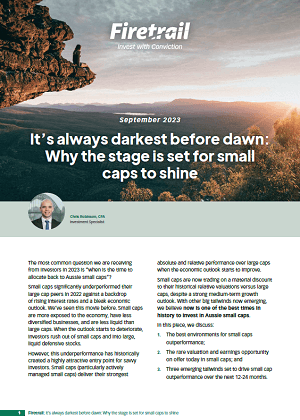by Chris Robinson, CFA, Investment Specialist
The most common question we are receiving from investors in 2023 is “when is the time to allocate back to Aussie small caps”?
Small caps significantly underperformed their large cap peers in 2022 against a backdrop of rising interest rates and a bleak economic outlook. We’ve seen this movie before. Small caps are more exposed to the economy, have less diversified businesses, and are less liquid than large caps. When the outlook starts to deteriorate, investors rush out of small caps and into large, liquid defensive stocks.
However, this underperformance has historically created a highly attractive entry point for savvy investors. Small caps (particularly actively managed small caps) deliver their strongest absolute and relative performance over large caps when the economic outlook starts to improve.
Small caps are now trading on a material discount to their historical relative valuations versus large caps, despite a strong medium-term growth outlook. With other big tailwinds now emerging, we believe now is one of the best times in history to invest in Aussie small caps.
Download the full paper
